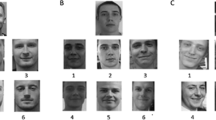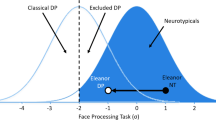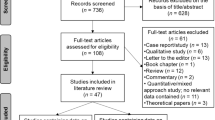Abstract
This study examines whether deficits in visual information processing in autism-spectrum disorder (ASD) can be offset by the recruitment of brain structures involved in selective attention. During functional MRI, 12 children with ASD and 19 control participants completed a selective attention one-back task in which images of faces and houses were superimposed. When attending to faces, the ASD group showed increased activation relative to control participants within multiple prefrontal cortex areas, including dorsolateral prefrontal cortex (DLPFC). DLPFC activation in ASD was associated with increased response times for faces. These data suggest that prefrontal cortex activation may represent a compensatory mechanism for diminished visual information processing abilities in ASD.


Similar content being viewed by others
References
American Psychiatric Association. (2013). Diagnostic and statistical manual of mental disorders (5th ed.). Arlington, VA: American Psychiatric Association.
Banich, M. T., Mackiewicz, K. L., Depue, B. E., Whitmer, A. J., Miller, G. A., & Heller, W. (2009). Cognitive control mechanisms, emotion and memory: A neural perspective with implications for psychopathology. Neuroscience and Biobehavioral Reviews, 33(5), 613–630.
Banich, M. T., Milham, M. P., Atchley, R. A., Cohen, N. J., Webb, A., Wszalek, T., et al. (2000). Prefrontal regions play a predominant role in imposing an attentional “set”: Evidence from fMRI. Cognitive Brain Research, 10(1–2), 1–9.
Bar, M., Kassam, K. S., Ghuman, A. S., Boshyan, J., Schmid, A. M., Schmidt, A. M., et al. (2006). Top-down facilitation of visual recognition. Proceedings of the National Academy of Sciences of the United States of America, 103(2), 449–454.
Baron-Cohen, S., Golan, O., & Ashwin, E. (2009). Can emotion recognition be taught to children with autism spectrum conditions? Philosophical Transactions of the Royal Society of London. Series B, Biological Sciences, 364(1535), 3567–3574.
Beck, D. M., & Kastner, S. (2009). Top-down and bottom-up mechanisms in biasing competition in the human brain. Vision Research, 49(10), 1154–1165.
Belmonte, M. K., & Yurgelun-Todd, D. A. (2003). Functional anatomy of impaired selective attention and compensatory processing in autism. Cognitive Brain Research, 17(3), 651–664.
Benton, A. (1994). Face recognition. Los Angeles, CA, USA: Western Psychological Services.
Bird, G., Catmur, C., Silani, G., Frith, C., & Frith, U. (2006). Attention does not modulate neural responses to social stimuli in autism spectrum disorders. NeuroImage, 31(4), 1614–1624.
Brassen, S., Gamer, M., Rose, M., & Büchel, C. (2010). The influence of directed covert attention on emotional face processing. NeuroImage, 50(2), 545–551.
Chevallier, C., Kohls, G., Troiani, V., Brodkin, E. S., & Schultz, R. T. (2012). The social motivation theory of autism. Trends in Cognitive Sciences, 16(4), 231–239.
Dakin, S., & Frith, U. (2005). Vagaries of visual perception in autism. Neuron, 48(3), 497–507.
Dawson, G., Webb, S. J., & McPartland, J. (2005). Understanding the nature of face processing impairment in autism: insights from behavioral and electrophysiological studies. Developmental Neuropsychology, 27(3), 403–424.
Dichter, G. S., Felder, J. N., & Bodfish, J. W. (2009). Autism is characterized by dorsal anterior cingulate hyperactivation during social target detection. Social Cognitive and Affective Neuroscience, 4(3), 215–226.
Dolcos, F., & McCarthy, G. (2006). Brain systems mediating cognitive interference by emotional distraction. The Journal of Neuroscience: The Official Journal of the Society for Neuroscience, 26(7), 2072–2079.
Dziobek, I., Bahnemann, M., Convit, A., & Heekeren, H. (2010). The Role of the Fusiform-Amygdala System in the Pathophysiology of Autism. Archives of General Psychiatry, 67(4), 397–405.
Elliot, C. (2007). The differential abilities scale, second edition (2nd ed.). San Antonio, TX: Harcourt Assessments Inc.
Endl, W., Walla, P., Lindinger, G., Lalouschek, W., Barth, F. G., Deecke, L., et al. (1998). Early cortical activation indicates preparation for retrieval of memory for faces: an event-related potential study. Neuroscience Letters, 240(1), 58–60.
Frith, U. (1989). Autism: Explaining the enigma. Oxford, UK: Basil Blackwell.
Frith, U., & Happé, F. (1994). Autism: Beyond “theory of mind”. Cognition, 50(1–3), 115–132.
Furey, M. L., Tanskanen, T., Beauchamp, M. S., Avikainen, S., Uutela, K., Hari, R., et al. (2006). Dissociation of face-selective cortical responses by attention. Proceedings of the National Academy of Sciences of the United States of America, 103(4), 1065–1070.
Fuster, J. M., Bauer, R. H., & Jervey, J. P. (1985). Functional interactions between inferotemporal and prefrontal cortex in a cognitive task. Brain Research, 330(2), 299–307.
Gadow, K. D., DeVincent, C. J., & Pomeroy, J. (2006). ADHD symptom subtypes in children with pervasive developmental disorder. Journal of Autism and Developmental Disorders, 36(2), 271–283.
Gargaro, B. A., Rinehart, N. J., Bradshaw, J. L., Tonge, B. J., & Sheppard, D. M. (2011). Autism and ADHD: How far have we come in the comorbidity debate? Neuroscience and Biobehavioral Reviews, 35(5), 1081–1088.
Gilbert, S. J., Bird, G., Brindley, R., Frith, C. D., & Burgess, P. W. (2008). Atypical recruitment of medial prefrontal cortex in autism spectrum disorders: An fMRI study of two executive function tasks. Neuropsychologia, 46(9), 2281–2291.
Gregoriou, G. G., Gotts, S. J., Zhou, H., & Desimone, R. (2009). Long-range neural coupling through synchronization with attention. Progress in Brain Research, 176, 35–45. doi:10.1016/S0079-6123(09)17603-3.
Harms, M. B., Martin, A., & Wallace, G. L. (2010). Facial emotion recognition in autism spectrum disorders: a review of behavioral and neuroimaging studies. Neuropsychology Review, 20(3), 290–322. doi:10.1007/s11065-010-9138-6.
Herrington, J. D., Nymberg, C., & Schultz, R. T. (2011a). Biological motion task performance predicts superior temporal sulcus activity. Brain and Cognition, 77(3), 372–381. doi:10.1016/j.bandc.2011.09.001.
Herrington, J. D., Taylor, J. M., Grupe, D. W., Curby, K. M., & Schultz, R. T. (2011b). Bidirectional communication between amygdala and fusiform gyrus during facial recognition. NeuroImage, 56(4), 2348–2355. doi:10.1016/j.neuroimage.2011.03.072.
Hill, E. (2004). Evaluating the theory of executive dysfunction in autism. Developmental Review, 24(2), 189–233. doi:10.1016/j.dr.2004.01.001.
Just, M. A., Cherkassky, V. L., Keller, T. A., Kana, R. K., & Minshew, N. J. (2007). Functional and anatomical cortical underconnectivity in autism: evidence from an FMRI study of an executive function task and corpus callosum morphometry. Cerebral Cortex, 17(4), 951–961.
Kenworthy, L., Yerys, B. E., Anthony, L. G., & Wallace, G. L. (2008). Understanding executive control in autism spectrum disorders in the lab and in the real world. Neuropsychology Review, 18(4), 320–338. doi:10.1007/s11065-008-9077-7.
Kohls, G., Schulte-Rüther, M., Nehrkorn, B., Müller, K., Fink, G. R., Kamp-Becker, I., Konrad, K. (2012). Reward system dysfunction in autism spectrum disorders. Social Cognitive and Affective Neuroscience, 8(5).
Koshino, H., Carpenter, P. A., Minshew, N. J., Cherkassky, V. L., Keller, T. A., & Just, M. A. (2005). Functional connectivity in an fMRI working memory task in high-functioning autism. NeuroImage, 24(3), 810–821.
Koshino, H., Kana, R. K., Keller, T. A., Cherkassky, V. L., Minshew, N. J., & Just, M. A. (2008). fMRI investigation of working memory for faces in autism: Visual coding and underconnectivity with frontal areas. Cerebral Cortex, 18(2), 289–300.
Leyfer, O. T., Folstein, S. E., Bacalman, S., Davis, N. O., Dinh, E., Morgan, J., et al. (2006). Comorbid psychiatric disorders in children with autism: Interview development and rates of disorders. Journal of Autism and Developmental Disorders, 36(7), 849–861.
Lord, C., Risi, S., Lambrecht, L., Cook, E. H. J., Leventhal, B. L., DiLavore, P. C., et al. (2000). The autism diagnostic observation schedule-generic: A standard measure of social and communication deficits associated with the spectrum of autism. Journal of Autism and Developmental Disorders, 30(3), 205–223.
Lord, C., Rutter, M., & Le Couteur, A. (1994). Autism Diagnostic Interview-Revised: A revised version of a diagnostic interview for caregivers of individuals with possible pervasive developmental disorders. Journal of Autism and Developmental Disorders, 24(5), 659–685.
Luks, T. L., & Simpson, G. V. (2004). Preparatory deployment of attention to motion activates higher-order motion-processing brain regions. NeuroImage, 22(4), 1515–1522. doi:10.1016/j.neuroimage.2004.04.008.
MacDonald, A. W, 3rd, Cohen, J. D., Stenger, V. A., & Carter, C. S. (2000). Dissociating the role of the dorsolateral prefrontal and anterior cingulate cortex in cognitive control. Science, 288(5472), 1835–1838.
Milham, M. P., Banich, M. T., & Barad, V. (2003). Competition for priority in processing increases prefrontal cortex’s involvement in top-down control: An event-related fMRI study of the stroop task. Cognitive Brain Research, 17(2), 212–222.
Milham, M. P., Banich, M., Webb, A., Barad, V., Cohen, N., Wszalek, T., et al. (2001). The relative involvement of anterior cingulate and prefrontal cortex in attentional control depends on nature of conflict. Cognitive Brain Research, 12(3), 467–473.
Miller, B. T., Vytlacil, J., Fegen, D., Pradhan, S., & D’Esposito, M. (2011). The prefrontal cortex modulates category selectivity in human extrastriate cortex. Journal of Cognitive Neuroscience, 23(1), 1–10.
Minshew, N. J., & Williams, D. L. (2007). The new neurobiology of autism: Cortex, connectivity, and neuronal organization. Archives of Neurology, 64(7), 945–950.
Miyashita, Y., & Hayashi, T. (2000). Neural representation of visual objects: Encoding and top-down activation. Current Opinion in Neurobiology, 10(2), 187–194.
Niendam, T. A., Laird, A. R., Ray, K. L., Dean, Y. M., Glahn, D. C., & Carter, C. S. (2012). Meta-analytic evidence for a superordinate cognitive control network subserving diverse executive functions. Cognitive, Affective, & Behavioral Neuroscience, 12(2), 241–268.
O’Craven, K. M., Downing, P. E., & Kanwisher, N. (1999). fMRI evidence for objects as the units of attentional selection. Nature, 401(6753), 584–587.
Ozonoff, S., & Strayer, D. L. (2001). Further evidence of intact working memory in autism. Journal of Autism and Developmental Disorders, 31(3), 257–263.
Pennington, B. F., & Ozonoff, S. (1996). Executive functions and developmental psychopathology. Journal of Child Psychology and Psychiatry and Allied Disciplines, 37(1), 51–87.
Rajkowska, G., & Goldman-Rakic, P. (1995). Cytoarchitectonic definition of prefrontal areas in the normal human cortex: II. Variability in locations of areas 9 and 46 and relationship to the Talairach Coordinate System. Cerebral Cortex, 5(4), 323–337.
Remington, A. M., Swettenham, J., Campbell, R., & Coleman, M. (2009). Selective attention and perceptual load in autism spectrum disorder. Psychological Science, 20(11), 1388–1393.
Schultz, R. T. (2005). Developmental deficits in social perception in autism: The role of the amygdala and fusiform face area. International Journal of Developmental Neuroscience, 23(2–3), 125–141.
Smith, S. M., Miller, K. L., Salimi-Khorshidi, G., Webster, M., Beckmann, C. F., Nichols, T. E., et al. (2011). Network modelling methods for FMRI. NeuroImage, 54(2), 875–891.
Tanaka, J. W., Wolf, J. M., Klaiman, C., Koenig, K., Cockburn, J., Herlihy, L., et al. (In press). The perception and identification of facial emotions in individuals with autism spectrum disorders using the Let’s Face It! Emotion Skills Battery. Journal of Child Psychology & Psychiatry.
Tanaka, J. W., Wolf, J. M., Klaiman, C., Koenig, K., Cockburn, J., Herlihy, L., et al. (2010). Using computerized games to teach face recognition skills to children with autism spectrum disorder: The Let’s Face It! program. Journal of Child Psychology and Psychiatry and Allied Disciplines, 51(8), 944–952.
Vuilleumier, P., & Pourtois, G. (2007). Distributed and interactive brain mechanisms during emotion face perception: Evidence from functional neuroimaging. Neuropsychologia, 45(1), 174–194.
Ward, D. B. (2006). Simultaneous inference for fMRI data. Retrieved from http://afni.nimh.nih.gov/pub/dist/doc/manual/AlphaSim.pdf.
Wechsler, D. (1997). Wechsler adult intelligence scale (3rd ed.). San Antonio, TX: Harcourt Assessments Inc.
Wechsler, D. (1999). Wechsler abbreviated scale of intelligence. San Antonio, USA: The Psychological Corporation.
Wechsler, D. (2003). The wechsler intelligence scale for children—Fourth Edition (4th ed.). San Antonio, TX: The Psychological Corporation.
Wolf, J. M., Tanaka, J. W., Klaiman, C., Cockburn, J., Herlihy, L., Brown, C., et al. (2008). Specific impairment of face-processing abilities in children with autism spectrum disorder using the Let’s Face It! skills battery. Autism Research, 1(6), 329–340.
Acknowledgments
Funding for this project was provided by an award from NIMH (R01MH073084) to R. Schultz. Portions of these data were presented at the 40th Annual Meeting of the Society for Neuroscience, San Diego, 2010. J. Herrington and R. Schultz reported having received lecture fees and research funds from Shire Pharmaceuticals. Additionally, R. Schultz reported receiving lecture fees from Pfizer and Hoffman-La Roche, and research funds from Pfizer. M. Riley and D. Grupe reported no biomedical financial interests or potential conflicts of interest. We would like to thank Elinora Price and Julie Wolf for their roles in recruiting and testing research participants for this study.
Author information
Authors and Affiliations
Corresponding author
Rights and permissions
About this article
Cite this article
Herrington, J.D., Riley, M.E., Grupe, D.W. et al. Successful Face Recognition is Associated with Increased Prefrontal Cortex Activation in Autism Spectrum Disorder. J Autism Dev Disord 45, 902–910 (2015). https://doi.org/10.1007/s10803-014-2233-4
Published:
Issue Date:
DOI: https://doi.org/10.1007/s10803-014-2233-4




